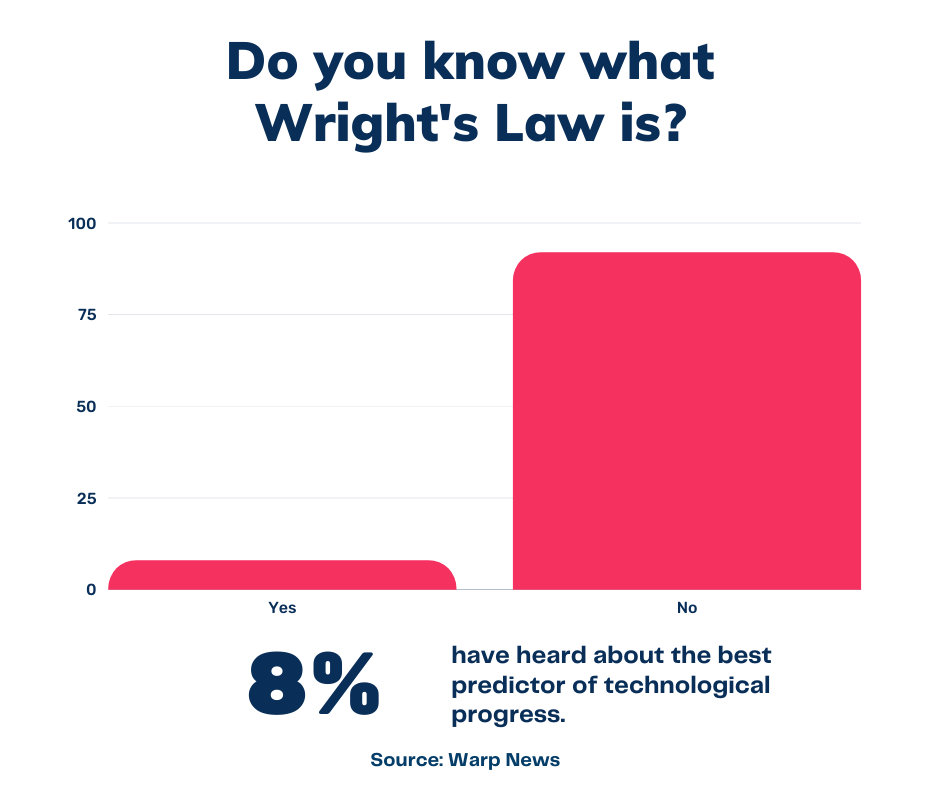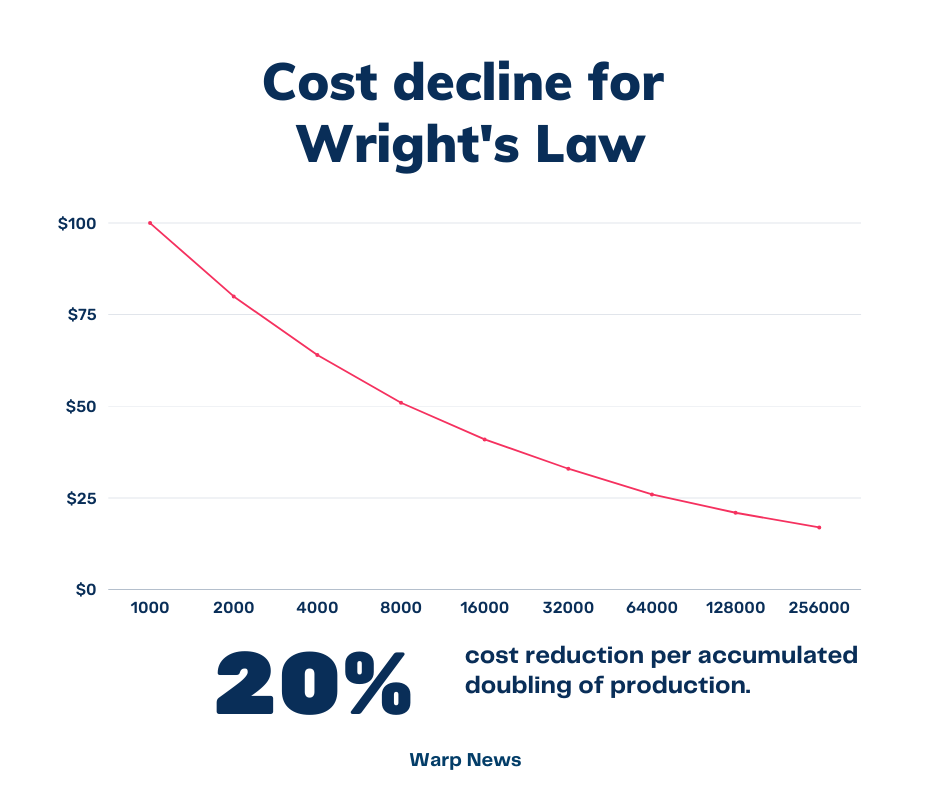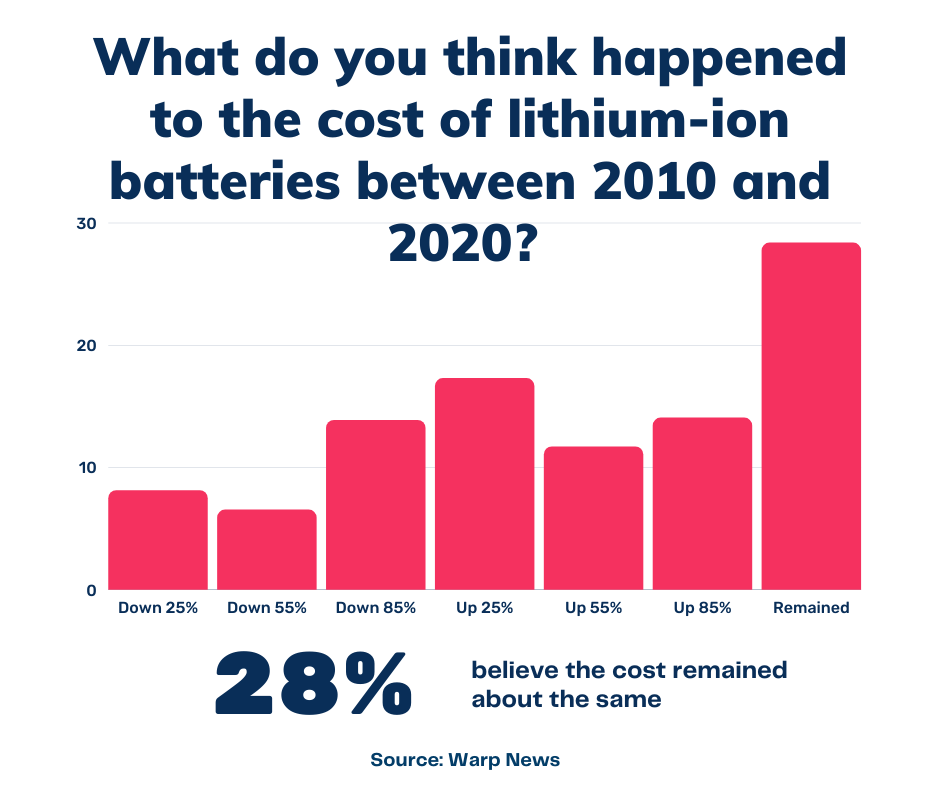
💡 Optimist's Edge: According to MIT this law is the best way to predict the future
9 out of 10 have never heard of the law that, according to MIT, predicts technological progress better than any other. Here is the secret law.
Share this story!
Summary
📉 What people don't know
There are models that accurately predict technological progress, but 92 percent in our survey have not even heard of the best one.
📈 Here are the facts
The best model is Wright’s Law, according to research measuring historical data from 62 different technologies.
In the rule of thumb for the law costs drop 20 percent for every accumulated doubling of production.
💡 The Optimist’s Edge
Using Wright’s Law you can look at production data of a technology and make accurate predictions about future costs.
For example, if you look at lithium-ion batteries you can predict when electric vehicles will be cheaper to buy than cars with an internal combustion engine: Optimist's Edge: This is when electric cars will be cheaper than petrol cars.
👇 This is how you get the edge
The super simple version of this law is that if you see the production of a technology increasing, you know the cost will decline. (Many people don't know this.)
With just a little research you can often find historical production data and prognosis on future production, and with just that you can make a pretty good estimate of what the future price will be.
📉 What people don't know
92 percent do not know what Wright’s Law is.

📈 Here are the facts about Wright's Law
Predictions are hard, especially about the future, as Niels Bohr said. Or was it Mark Twain? Either way, there are models you can use to help.
Researchers at MIT tested different models for predicting technological progress. They used historical data from 62 different technologies, divided into four groups: Chemical, Hardware, Energy and Other.
All models were actually pretty accurate, but the best one was Wright’s Law.
Rule of thumb: 20 percent reduction in cost when production doubles
Wright's Law focuses on the number of units produced. For each accumulated doubling of production, the associated cost drops by a certain percentage. In the rule of thumb, it is 20 percent.
If we have so far produced 1000 units of a product, then the cost per unit will decrease by 20% when production reaches 2000 units.
Another 20% reduction happens at 4,000, then another at 8,000, and so on.
If the cost of producing unit number 1000 is $100, then the cost of unit number 2000 will be $80. For unit number 4000, the cost will be $64, and for unit number 8000 it will be $51.

For very mature products every doubling can take many years.
Total production for cars with internal combustion engines doubles every 29 years, at the current rate. So the 20 percent drop is still there, it just takes a very long time, since over two billion cars have been produced.
Who was Wright?
Theodore Paul Wright, T.P., was an aircraft engineer that in 1936 formulated what is now known as Wright’s Law in a paper on the cost of airplanes.
Every time total aircraft production doubled, the required labor time for a new aircraft fell by 20 percent.
Wright was not related to the Wright brothers (but to confuse things, he did receive the Wrights Brothers medal in 1930.)
Wright’s Law formula
Y = cumulative average time (or cost) per unit
X = cumulative number of units produced
a = time (or cost) required to produce 1st unit
b = slope of the function

💡 The Optimist’s Edge
Just knowing the basic rule of thumb helps
Just knowing the basic rule of Wright’s Law gives you an edge over most people: Costs declines with increased production.
If production increases fast, costs will drop fast.
When we asked people what they thought about the cost of lithium-ion batteries the last ten years, most people thought they had gone up or remained the same, when they in fact declined 85 percent.

👇 How to get the edge
There are two main ways that you can use Wright’s Law: A detailed prediction, or as a rule of thumb to get a rough understanding of the future for certain technologies.
Detailed prediction of the future
Sometimes you need a detailed understanding of the future. You need to dig up or create accurate historical data on production and cost. With that, you can determine how much the cost declines per doubling in accumulated production.
You also need a good estimate of future production. This is of course the trickiest part and important to keep track going forward.
For example, research company Bloomberg NEF, looked at cost decline related to production for lithium-ion batteries from 2010 to 2020. Over this ten-year period total production doubled almost ten times, giving an average cost decline per doubling of 18 percent.
Using estimates of future production that could provide you with information like when lithium-ion batteries have become cheap enough to give electric vehicles lower sticker prices than fossil-fueled cars. In this example, that will occur around 2024.
In this case Bloomberg NEF have done a lot of the work for us, but in other cases you might have to put together the data yourself. That could be pretty complicated, time-consuming and expensive, but sometimes accuracy is important enough to justify that.
Rough understanding of the future
In most instances the rule of thumb is enough.
You need some sort of historical data to give a ballpark figure of how often accumulated production doubles. Is it every year, every five years, every ten years?
With the historical data you can see if the time to double production is speeding up or slowing down and out of that you can guesstimate how often production will double in the coming years.
Using a 20 percent cost decline per doubling, you will arrive at a pretty good estimate of the future for that technology.
Warning: It is hard to predict the future
It is important to update your thinking regularly.
Let’s say you do a Wright’s Law analysis on screens, like computer screens and TV screens. But then two years later Apple launches augmented reality glasses that make most screens unnecessary because the screen is digital in your glasses. That could lead to a lot of physical screens being replaced by digital screens, and the production of physical screens slows down.
Wright’s Law still applies, but you need to update your estimate on future production based on the new reality.
So it is crucial to keep up to date with many different technologies. But as it happens, that is exactly what we are here to help you with.
You now have an edge because you have gained this knowledge before most others – what will you do with your Optimist's Edge?
❓ What more can you do?
Please share more ideas with your fellow Premium Supporters in our Facebook group.
Note: The surveys were conducted on 250 and 500 respondents using Google Surveys.
By becoming a premium supporter, you help in the creation and sharing of fact-based optimistic news all over the world.


